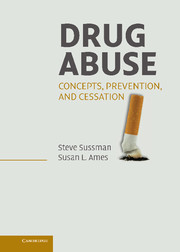Book contents
- Frontmatter
- Contents
- Preface
- Acknowledgments
- SECTION ONE CONCEPTS AND CLASSES OF DRUGS
- SECTION TWO ETIOLOGY
- SECTION THREE PREVENTION
- 10 Concepts of Prevention
- 11 Neurobiologically Relevant
- 12 Cognitive Processes
- 13 Social Interaction and Social Groups
- 14 The Large Social and Physical Environment
- SECTION FOUR CESSATION
- SECTION FIVE CONCLUSIONS AND THE FUTURE
- References
- Author Index
- Subject Index
14 - The Large Social and Physical Environment
Published online by Cambridge University Press: 18 December 2009
- Frontmatter
- Contents
- Preface
- Acknowledgments
- SECTION ONE CONCEPTS AND CLASSES OF DRUGS
- SECTION TWO ETIOLOGY
- SECTION THREE PREVENTION
- 10 Concepts of Prevention
- 11 Neurobiologically Relevant
- 12 Cognitive Processes
- 13 Social Interaction and Social Groups
- 14 The Large Social and Physical Environment
- SECTION FOUR CESSATION
- SECTION FIVE CONCLUSIONS AND THE FUTURE
- References
- Author Index
- Subject Index
Summary
Drug misuse prevention programming at the larger socioenvironmental level can have wide-ranging effects because large-scale influences are inextricably intertwined with multiple levels of experience. That is, if large socioenvironmental programming is virulent, it can affect micro-group and individual perceptions, attitudes, and behavior. Large social environmental influences on drug misuse prevention include culturally expressed communications through numerous community channels that may monopolize messages being provided to youth. For example, antidrug communications may be diffused through mass media messages such as newspapers, billboards, and movies, in various languages, with various role models depicted. Appropriately placed anti-drug misuse messages that are repeated several times might produce a preventive effect.
Large physical environmental influences on drug misuse include presence or level of drug manufacturing and distribution channels (e.g., presence of poppy fields) or, conversely, presence of prosocial physical resources (e.g., presence of well-supplied schools, libraries, and sports facilities). Prosocial resources availability (e.g., teen centers and libraries) might lead youth to seek out options other than drug use. Supply reduction approaches (e.g., policy enactment and enforcement) may decrease or redirect drug distribution, perhaps lowering drug use. This chapter focuses on larger social and physical environmental prevention approaches.
Large Social Environmental Change
Large social environmental prevention approaches (e.g., community interventions) often involve the systemization of a large social system within which prevention programming may be diffused. Community interventions may involve a range of program channels (e.g., school, family groups, media, community agencies, local government, church, and health groups), coalitions or partnerships, levels of community resources (e.g., face-to-face assistance and physical structures), depth of programming (e.g., intensity, number of contacts), and gatekeeper follow-through to facilitate program implementation (see Pentz, 1986).
- Type
- Chapter
- Information
- Drug AbuseConcepts, Prevention, and Cessation, pp. 193 - 204Publisher: Cambridge University PressPrint publication year: 2008



